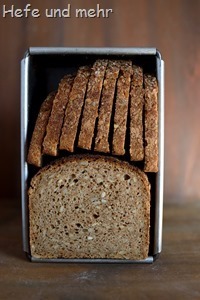Heißewecken
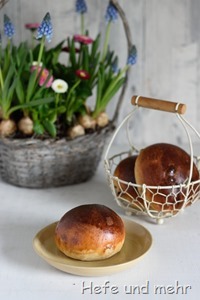 Heißewecken – sometimes called Hedewäggen, Hetwegge, Heiteweggen or Heetwich, too – are spiced raisin buns which are typical for North Germany. Their form vary from region to region, sometimes they are baked in bun shape, in others regions they are baked as flatbreads. They are baked traditionally in the feasting time between carnival and Easter and often served with warm milk and butter.
Heißewecken – sometimes called Hedewäggen, Hetwegge, Heiteweggen or Heetwich, too – are spiced raisin buns which are typical for North Germany. Their form vary from region to region, sometimes they are baked in bun shape, in others regions they are baked as flatbreads. They are baked traditionally in the feasting time between carnival and Easter and often served with warm milk and butter.
I have them on my list of regionals breads I want to bake for already one year. And before it is Easter again I finally managed to bake them. I chose the bun shape over the flatbread as I find the buns easier to eat for breakfast. But you can easily roll the dough to small flatbreads, too. Both forms are baked fast and hot which ensured a moist crumb.
I like the fine crumb and soft crust of this rolls very much. Cinnamon and Cardamom add a delicious deepness to the flavour and I ask myself why it took me so long to bake them …
Bergneustädter
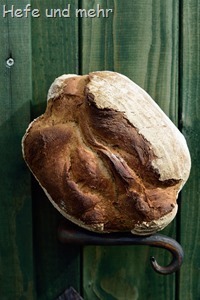 All the winter I did not make it to one of the bread baking days in our local history museum. It was due to different reasons: a lot of snow, a bad cold, our spontaneous weekend trip into the Ardennes…
All the winter I did not make it to one of the bread baking days in our local history museum. It was due to different reasons: a lot of snow, a bad cold, our spontaneous weekend trip into the Ardennes…
But last weekend I finally was back and it was so good to meet all the nice people there once again. And as every time I was enchanted by all the little details around the wood fired oven and took many photos.
To honour the museum I call the bread I baked this time “Bergneustädter” as the Museum is seated at the historical centrum of the little town Bergneustadt. It is a bread made with white wheat and rye flour. To keep the bread moist for a long time I added a bit of potato flakes and a little bit of butter, too. The roasted malt enhances the subtle smoke notes of the wood fired oven. For rising the bread adding my hyperactive sourdough would be enough. But as a wood fired oven waits for no one I kept on the secure side and added a bit of yeast to make the proofing better controllable. So the bread needed 60 min to be ready for baking, which is fits perfect in the time schedule I have in the museum.
Three Grain Bread (Variant 2)
Sometimes I have “phases” in which I concentrate on a special topic while baking. At the moment it is whole grain. Maybe the very cold or dark winter is the reason why I am craving for grains, I do not know. But it is as it is and so I played a bit with the recipe I posted two weeks ago. The result is a beginner friendly bread which needs not so much planning as works without preferment. To still archive a balanced flavour I opted for a mixture of buttermilk and a tiny bit of balsamico. The amount of balsamico has to be well balanced, as to much can cause a unwelcome stingy tartness. But carefully dosed it creates a flavour with reminders of sourdough taste.
For the rest, I keep the parameters: enough time for kneading and proofing, so the whole grain flour can soak up all liquid its need. And for a little change in the palate I switched wheat with emmer flour. But if you have no emmer flour at hand, it can be baked with spelt flour all along, too.
Buttery Whole Wheat Rolls
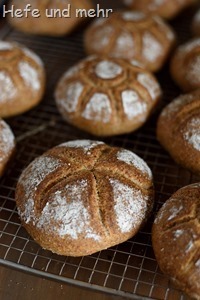 The second recipe I got from my parents neighbour which needed a bit of work over was a recipe for whole grain rolls with milk and a good portion of butter. I liked the idea of this rolls instantly.
The second recipe I got from my parents neighbour which needed a bit of work over was a recipe for whole grain rolls with milk and a good portion of butter. I liked the idea of this rolls instantly.
I added poolish for more flavour and a water roux to make the dough more easy to handle. The other adjustment I made was concerning kneading and fermenting time. Kneading the dough until full gluten development is an important point here as a well developed dough keeps water much better. And as I told already last week, it is important that a whole grain dough gets enough time to soak up the liquid, too. This helps to improve the crumb as well as the shelf life. And in combination these all leads to a dough which is firm enough to get stemped with a roll stemp.
Beside of this I finetuned the recipe a bit, reducing the amount of yeast (once more) and adding an egg as lecithin source. This helps to create a fluffy roll with good volume and fine flavour. The buttery notes pair up very well with the nutty yet slightly bitter flavour of whole grain. These are rolls with potential for favourite rolls.
Three Grain Bread
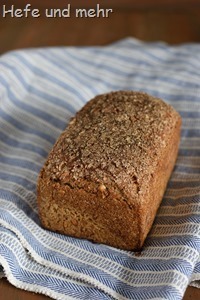 Some time ago my mum handed two recipes to me. A very dear neighbour of my parents asked if I could give the recipes a work-over. And as its due to my mum and me that she got the bread baking virus, I could not deny. But the first look on the recipe made me sigh. It was a variant of the infamous “three minute bread”. There are many variants of this bread available, but all suffers at a stable crumb and a all overpowering yeast flavour.
Some time ago my mum handed two recipes to me. A very dear neighbour of my parents asked if I could give the recipes a work-over. And as its due to my mum and me that she got the bread baking virus, I could not deny. But the first look on the recipe made me sigh. It was a variant of the infamous “three minute bread”. There are many variants of this bread available, but all suffers at a stable crumb and a all overpowering yeast flavour.
The yeast flavour is due to an overdosed amount of yeast. This can be easily fixed by reducing the yeast amount. Fixing the crumb needs a bit more work and time. Most important is to knead the bread thoroughly. Beside of kneading giving the flour enough time to soak is important, too. And so I added a Soaker and a Sourdough and added proper time for fermentation.
The bread is not a three minute bread anymore. It needs time like every good bread, but this time is well invested. The bread has well balanced flavour and moist, but stable crumb. A delicious bread for my lunch at school!
Spelt Burger Bun
 There is no shortage for burger bun recipes here in the blog. But while I am not willing to discuss a change by the patty (it HAS to be my vegan ABC-Burgerpatty) we like a change by the bun. And when we decided spontaneously that we would like to eat Burger for Dinner, I opted to bake spelt buns this time. When I checked the blog, I realized that I published no spelt variant until now. Something I had to change instantly, of course.
There is no shortage for burger bun recipes here in the blog. But while I am not willing to discuss a change by the patty (it HAS to be my vegan ABC-Burgerpatty) we like a change by the bun. And when we decided spontaneously that we would like to eat Burger for Dinner, I opted to bake spelt buns this time. When I checked the blog, I realized that I published no spelt variant until now. Something I had to change instantly, of course.
As the recipe is one for baking without long planning, there is no prefermet involved. To deepen the flavour non the less, I added some sourdough from the fridge and used it refresh my sourdough all along. For keeping the moisture in the dough, I opted for physillium hulls (no need to wait for a water roux cooling). And I added a good portion of freshly milled spelt, enough for some nutty flavour but not so much that it would compromise the fluffiness of the bun. It worked well together and after four hours we were able to serve some delicious burger along with sweet potatoe fries.
Goldknödel (low fructose)
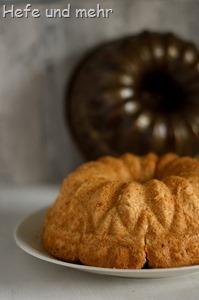 Goldknödel, the Transylvanian variant of monkey bread, is a all-time family favourite in the extended family. But as we have a genetic deposition for fructose intolerance some family members have to have a close look on their fructose intake. And as my favourite cousin asked for a low fructose Goldknödel for her birthday a work-over was necessary.
Goldknödel, the Transylvanian variant of monkey bread, is a all-time family favourite in the extended family. But as we have a genetic deposition for fructose intolerance some family members have to have a close look on their fructose intake. And as my favourite cousin asked for a low fructose Goldknödel for her birthday a work-over was necessary.
The main point was exchanging sugar (saccharose) with glucose. And as I made the experience before that to much glucose will dry the dough, I added a water roux to keep the dough fluffy soft and moist. As my cousin can eat some nuts, I halved the normal amount. Adding some tonka bean helps to replace the missing nut flavour.
And with this few changes on the recipe it results in a cake that tastes nearly indistinguishable with the “normal” variant. If you can not tolerate nuts at all, I would replace it with a teaspoon of cinnamon. That gives the cake a different flavour, but tastes good too.
Spelt Sandwich Bread (60% Whole Grain)
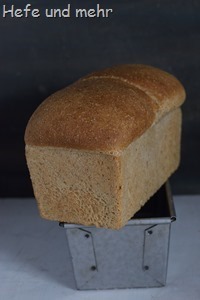 Step for Step I move nearer to my whole grain sandwich bread with a great amount of ancient grain. After the variant of with 30% whole emmer flour and white wheat flour worked so well, I tried this time a spelt sandwich bread with 60% whole grain. I decided to use a whole egg instead of egg yolk, as the egg white helps to stabilize the crumb. The rose hip powder adds vitamine C which enhances the gluten network. Instead of rose hip powder you can use acerola cherry juice as well. A well developed gluten network is one key to a fluffy bread with a good volume. Butter helps to keep the crump tender.
Step for Step I move nearer to my whole grain sandwich bread with a great amount of ancient grain. After the variant of with 30% whole emmer flour and white wheat flour worked so well, I tried this time a spelt sandwich bread with 60% whole grain. I decided to use a whole egg instead of egg yolk, as the egg white helps to stabilize the crumb. The rose hip powder adds vitamine C which enhances the gluten network. Instead of rose hip powder you can use acerola cherry juice as well. A well developed gluten network is one key to a fluffy bread with a good volume. Butter helps to keep the crump tender.
I am very happy with the result. The flavour is nutty and mild, the crumb as fluffy as a good sandwhich bread should be. The next step is adding Emmer to the mixture…
Whole Spelt Brioche
![Vollkorn-Dinkel-Brioche[3] Vollkorn-Dinkel-Brioche[3]](https://www.hefe-und-mehr.de/wp-content/uploads/2018/01/Vollkorn-Dinkel-Brioche3_thumb.jpg) January was extraordinary dark this year. I miss the sun and feel that without I lack creativity. Yesterday, finally, we had a sunny day and so we spent a day outside. Coming home my mind happily mingled different ideas I had recently to bake a whole grain brioche.
January was extraordinary dark this year. I miss the sun and feel that without I lack creativity. Yesterday, finally, we had a sunny day and so we spent a day outside. Coming home my mind happily mingled different ideas I had recently to bake a whole grain brioche.
As adding some rose hip powered helped me to archive a better gluten structure in this bread I decided to test its power in a whole spelt variant of brioche. With some sweet starter for flavour and some finely grated orange peel to break the slight bitterness of whole grain, I kneaded a dough containing a good amount of egg and butter. Kneading a brioche dough is always thrilling. As soon as the butter is added to the mixture, it turns in a sloppy mess. This happens with wheat brioche dough as well, so do not panic. Just keep kneading. The dough needs time until it starts to come together once again, but it will. As spelt sensitive to overkneading, it is advisable to keep an eye on gluten development . Nevertheless aim for full gluten development. Then you will be rewarded with a delightful brioche with a tender crumb. The flavour is rich and buttery, with delicious orange notes. For me, it is an enrichment of my Sunday morning breakfast, especially in combination with my favourite orange jam!

![Ostern[3] Ostern[3]](https://www.hefe-und-mehr.de/wp-content/uploads/2018/03/Ostern3_thumb.png)
